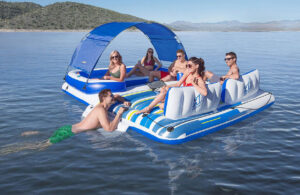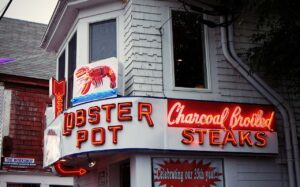On our way to British Columbia I had visions of watching grizzlies swat passing salmon out of the river for their dinner. The salmon runs are legendary and the stuff of National Geographic specials. I have seen enough documentaries to think it would be easy to hike up and pluck one out of the racing waters for dinner myself. Sometimes, I am so naïve.
We saw no salmon as we cruised from Vancouver to the island of Salt Spring. Orcas played in the bay as we ferried past. A seal bobbed his smooth head up and down to take a look as we kayaked. A bald eagle sat sentinel in a tall cedar, but no salmon.
In Tofino, as we hiked over rushing streams and through old-growth forests, I kept my eyes peeled for the flash of crimson. A website I’d read guaranteed that waters swarm with giant schools of salmon and that they would be gorging themselves on squid and herring to fatten themselves before winter. Fat, feeding fish; they should be easy to spot. But, the closest we got to sightings were on menus where fillets were roasted on cedar planks and in local shops, which sold packages of smoked salmon, salmon jerky and salmon candy.
In the two weeks we played in the waters, we didn’t see even one salmon. We left disappointed but with a knapsack full of the preserved product.
Over the fall and into winter my husband Patrick took to flaking the candied salmon on top of his bagel and cream cheese in the morning, slicing strips into his eggs and gnawing on ribbons in between meals. He was hooked. When thoughts turned to booking a snowboarding vacation, I think it was as much his dwindling supply ofcandied salmon as his longing to board Whistler, British Columbia, that chose the destination.
White welcomed us. Snow covered the ground and coated the trees. It fell from the sky and stuck to my eyelashes. I was pretty certain there would be no salmon this visit, either.
But that was before I entered Squamish Lil’wat Cultural Centre to learn more about the First Nations people of the area. Two distinct scents battled for my attention as I entered the doors. The smell of cedar from the walls hung thick in the air, but wafting up from below and mingling with the sauna-smell was a deeper, smokier sweet smell.
“Ken is smoking a batch of candied salmon,” the tour guide told me.
I had trouble concentrating while she explained the differences in the hand-carved canoes of red cedar used for hunting or fishing. I only half-listened to the stories of the masks that depicted legends of how the world worked and barely glanced at the 12-foot totems being carved to depict ravens, bears and orcas. My mind was on that salmon candy.
I skipped the “Where Rivers, Mountains and People Meet” film and made my way down to the kitchen to speak with Ken.
“The traditional recipe uses things that are found here.” Ken, an older Squamish man with short-cropped silver hair waved his hand to indicate the majestic view out the window. Alder trees towered over the scene back-dropped by snow-covered coastal mountains. “Salmon from the rivers, honey from the bees, berries gathered from the meadows and smoke from the alders.” It was the bounty of British Columbia.
“Traditionally, the elders smoke-dried salmon on racks above a smoldering fire,” Ken told me. “Today, I use a commercial smoker. Things have changed a lot for the First Nations people and the salmon since those days.” Ken’s brown eyes twinkled with a smile, but he was right. Both the salmon and his people are diminished in number.
In 2010, when the Winter Olympics in Vancouver made Ken’s candied salmon famous, he began to receive requests to ship his salmon candy all over the world.
Ken refused but replied to each request with a smile. “There is always a fresh batch waiting when you return.”
I may not have fished a salmon out of the river for dinner, but when we left British Columbia this time, I carried not only a knapsack full of salmon but also a promise from Ken of more when we next return.
KEN’S CANDIED WILD SALMON (A.K.A. Salmon Candy)
(Recipe courtesy of the Squamish Lil’wat Cultural Centre)
2 whole fresh wild salmon filets — skin-on, pin bones removed
1 1⁄2 cups plus 2 tablespoons natural brown sugar
1 cup kosher salt
1 tablespoon plus 1 teaspoon fresh ground pepper
2-3 cups wood chips
1⁄2 cup fresh blueberries
2 tablespoons unpasteurized honey
Make 1-inch vertical slices on each filet. Grasp each end of the filet and pull the skin so that the portions of fish separate a bit at each cut.
Set the filets on a rimmed baking sheet. Stir together 1 1⁄2 cups of the brown sugar, the salt and 1 tablespoon of the pepper until well blended. Use your fingers to evenly pack the mixture over each filet. Cure in the refrigerator overnight uncovered.
The next day, rinse the cure from the salmon fillets, pat dry with paper towels and allow to air-dry for one hour.
Preheat a smoker or grill for indirect heat. Add about 2 cups of the dry wood chips to the smoker or grill.
Smoke the fillets for one hour. Prop the lid open to allow airflow; the objective is to smoke the fillets but not cook them. Keep the temperature below 120 degrees for the entire time, just enough heat to create smoke. Add more wood chips if needed to maintain the smoke.
While the salmon is smoking, combine blueberries, honey, the remaining 2 tablespoons of brown sugar and remaining 1 teaspoon of pepper in a small bowl. Add a few tablespoons of boiling water and stir until the sugar has melted and the mixture has a sticky consistency, mashing the blueberries against the side of the bowl to form a glaze.
Brush this glaze over the salmon when it is done smoking and leave the salmon on the grill for two more hours to allow the glaze to dry.
Serve the salmon as you would other smoked salmon or flake it onto a salad.




